1993 CHEVROLET S10 service
[x] Cancel search: servicePage 227 of 356
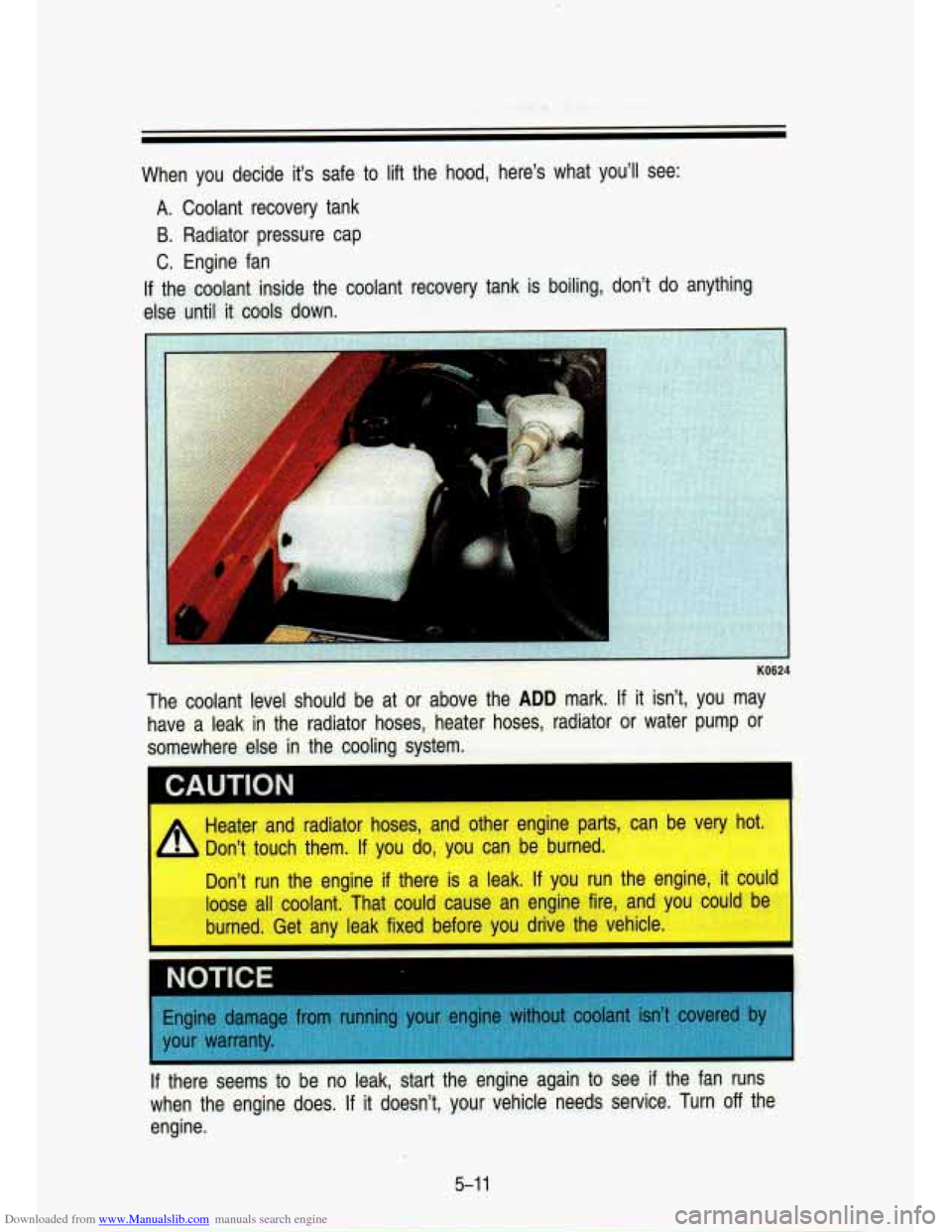
Downloaded from www.Manualslib.com manuals search engine When you decide it's safe to lift the hood, here's what you'll see:
A. Coolant recovery tank
B. Radiator pressure cap
C. Engine fan
If the coolant inside the coolant recovery tank is boiling, don't do anything
else until it cools down.
The coolant level should be at or above the
ADD mark. If it isn't, you may
have a leak in the radiator hoses, heater hoses, radiator or water pump or
somewhere else in the cooling system.
CAUTION I
Heater and radiator hoses, and other engine parts, can be very\
hot.
Don't touch them.
If you do, you can be burned.
loose all coolant. That could cause an engine fire, and you could be
burned. Get any leak fixed before you drive the vehicle. run the engine
if there is a leak. If you run the engine, it could
NOTICF
If there seems
to be no leak, start the engine again to see if the fan runs
when the engine does.
If it doesn't, your vehicle needs service. Turn off the
engine.
5-1 1
Page 249 of 356
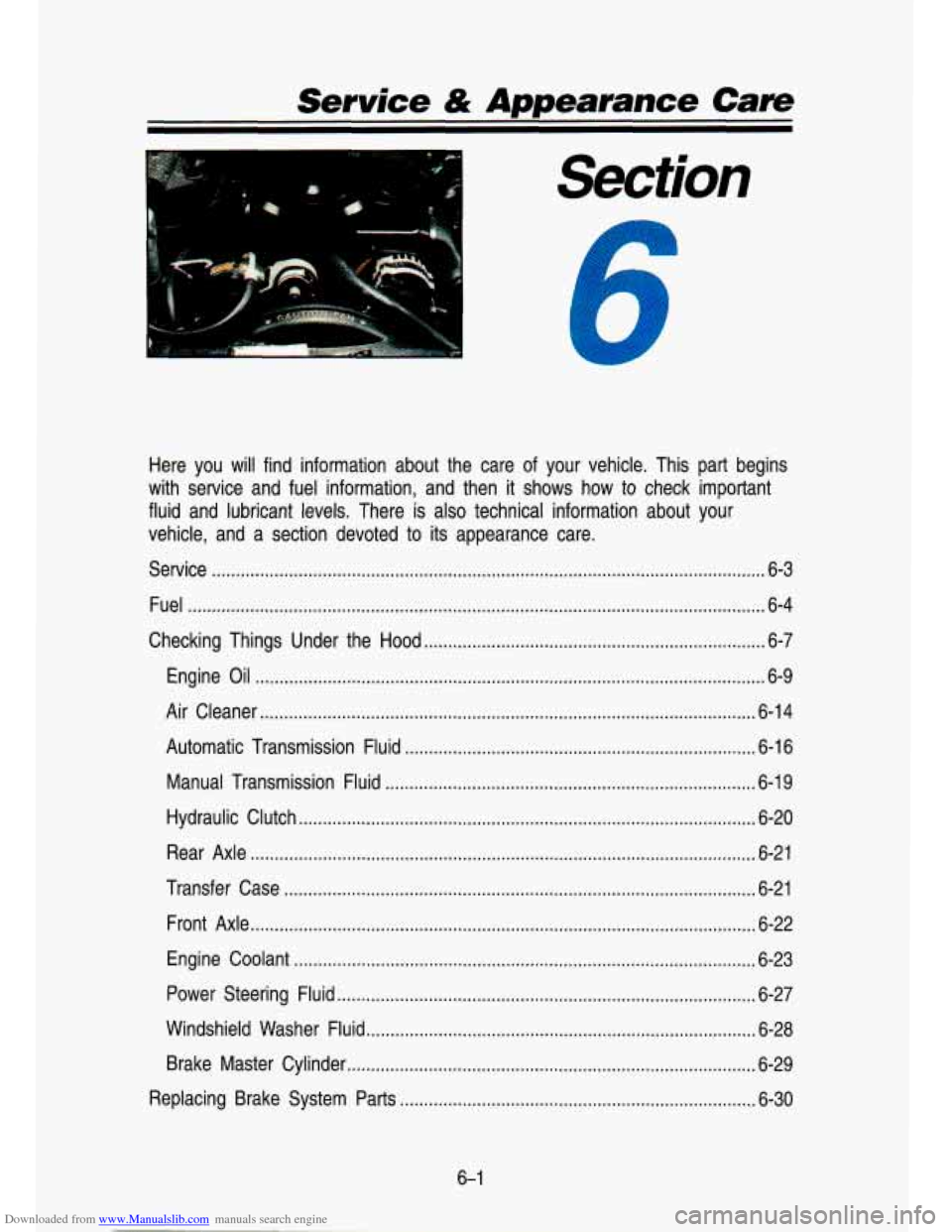
Downloaded from www.Manualslib.com manuals search engine Service & Appearance Care
-
Section
Here you will find information about the care of your vehicle. This part begins
with service and fuel information, and then it shows how to check important
fluid and lubricant levels. There
is also technical information about your
vehicle, and a section devoted to its appearance care.
Service
.. . . .. . . . . , . , . . r.l. .. . . .. ,. . . . . . . . . , , . . . . . . .. , . . .. , . . . . . . . . . . . . . . . . . . . . ..,. . . . . . . . . . . . . . . .=. . . . . . . . . . . . .. . .=. . . . . 6-3
Fuel
...... . .. .. . . . . ....... , .. . .. . . . . . . ... . .. ... .. ... .... .. . . . . . . ... . . .. . .. . ... ,..,, ,. .. . .. .. . .. . . .... . *. . . ., . . . .. .. .. 6-4
Checking Things Under the
Hood .................................................................,..... \
6-7
Engine Oil
I.....................1............11..........,.......,.,..I...........\
........r............. .......,. .... 6-9
Air Cleaner
..................,................................................. ...... .... ...- ......... - ..... ...... 6-14
Automatic Transmission Fluid
....... . .. . . .. . . . . .. ....-. . ... . . . . . .. .. . . . . . . . . . ... .. . . . . .. . ... . . ...... .. 6-16
Manual Transmission Fluid
....,. , . . . . ....... ... . . . .. .. . . . .. .. . .. .. . . ... . .. . . . . .. . ... . ... . . ... . . ... . . . .. 6-1 9
Hydraulic Clutch
,..........,......,....,..........I...I....I...................... ...................... ..... 6-20
Rear Axle
............ ..................... = .............I...............I..I........................ -.. ..... . .... ..... 6-21
Transfer Case
................................................,.~.....................\
..........................6-21
Front Axle .......I.............I......I.....................r..........I...r......\
............I......I.II...I...... 6-22
Engine Coolant
........................... ~ ................................. r..l ................................ 6-23
Power Steering Fluid
.....,. 3.,Iri.1111r ..................................................................... 6-27
Windshield Washer Fluid
...................................................... .................... 6-28
Brake Master Cylinder
........ . . . . .. . .... . .. .. . . . . ... . . . . .. . . . .. ..... .... . . . . . . . .. .. . . . . . .6-29
Replacing Brake System Parts
............................................................,..........,\
.. 6-30
6-1
Page 250 of 356
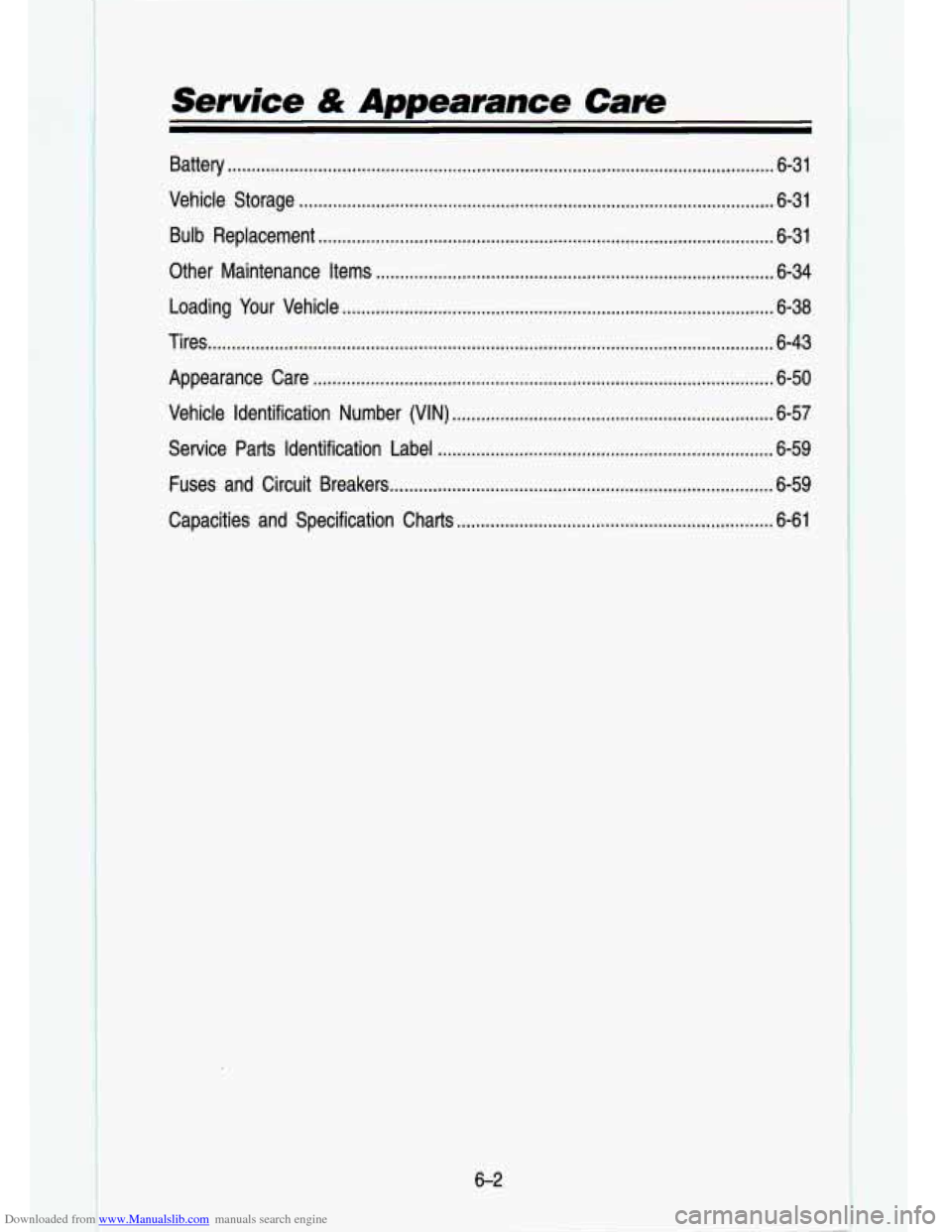
Downloaded from www.Manualslib.com manuals search engine Service & Appearance Care
Battery ........................................................................\
.......................................... 6-31
Vehicle Storage
........................................................................\
........................... 6-31
Bulb Replacement
........................................................................\
....................... 6-31
Other Maintenance Items
........................................................................\
........... 6-34
Loading Your Vehicle
........................................................................\
.................. 6-38
Tires ........................................................................\
.............................................. 6-43
Appearance Care
........................................................................\
........................ 6-50
Vehicle Identification Number (VIN)
................................................................... 6-57
Service Parts Identification Label
...................................................................... 6-59
Fuses and Circuit Breakers ........................................................................\
........ 6-59
Capacities and Specification Charts
.................................................................. 6-61
6-2
t
Page 251 of 356
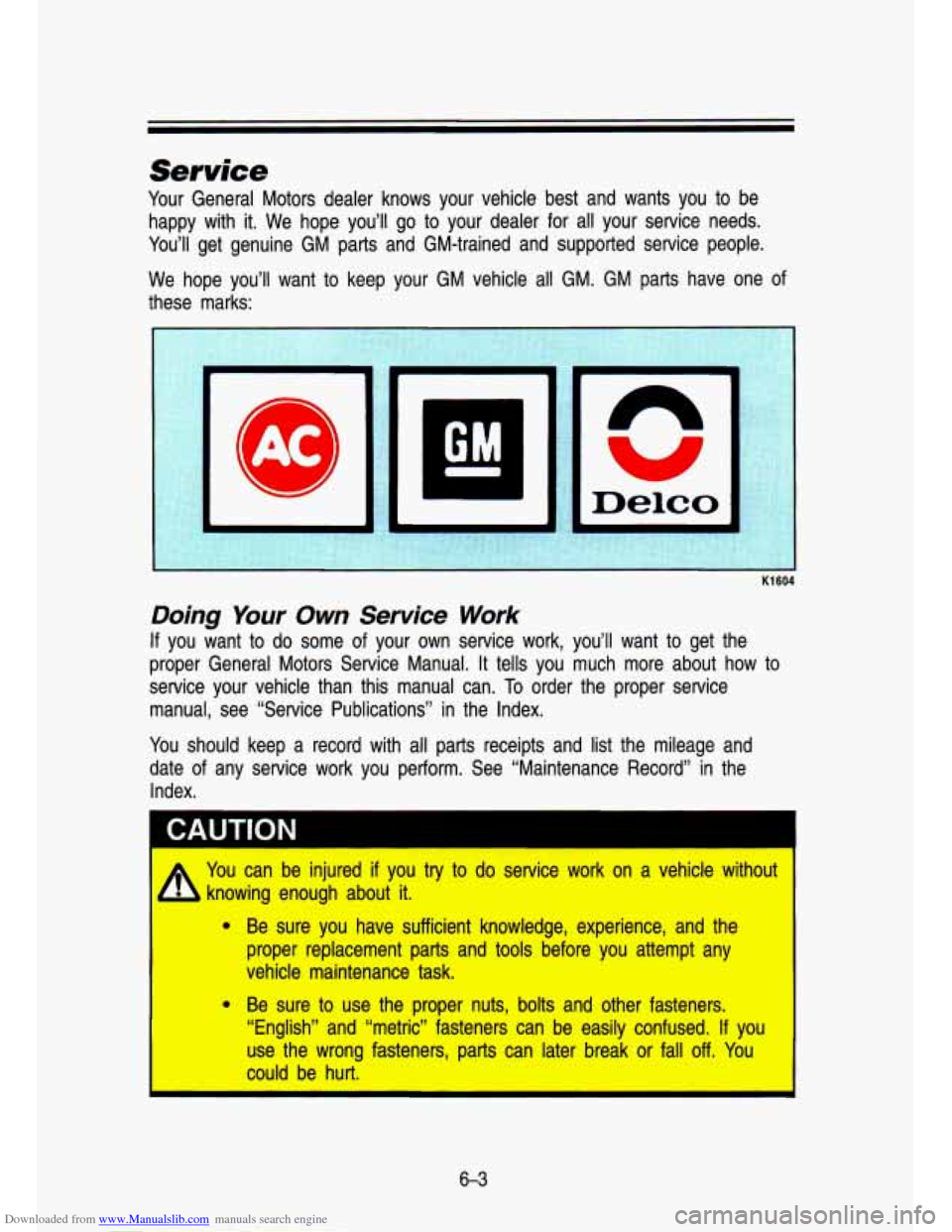
Downloaded from www.Manualslib.com manuals search engine Service
Your General Motors dealer knows your vehicle best and wants you to\
be
happy with it. We hope you’ll go to your dealer for all your service needs.
You’ll get genuine GM parts and GM-trained and supported ser\
vice people.
We hope you’ll want
to keep your GM vehicle all GM. GM parts have one of
these marks:
Doing Your Own Service Work
If you want to do some of your own service work, you’ll want to get the
proper General Motors Service Manual. It tells you much more a\
bout how to
service your vehicle than this manual can.
To order the proper service
manual, see “Service Publications” in the Index.
You should keep
a record with all parts receipts and list the mileage and
date of any service work you perform. See “Maintenance Record” \
in the
Index.
Yolu can be injured
if you try to do service work on a vehicle without
knowing enou’glh about it.
9 Be sure you have sufficient know18edge, experience, and the
proper replacement parts and tools before you attempt any
vehicle maintenance
task.
@~ Be sure to use th’e proper nuts, bolts and other fasteners.
“English” and “metric” fasEeners can be easily confused.
If you
use the wrong fasteners, parts can later break ‘ar fall
off. You
could be hurt.
6-3
Page 252 of 356
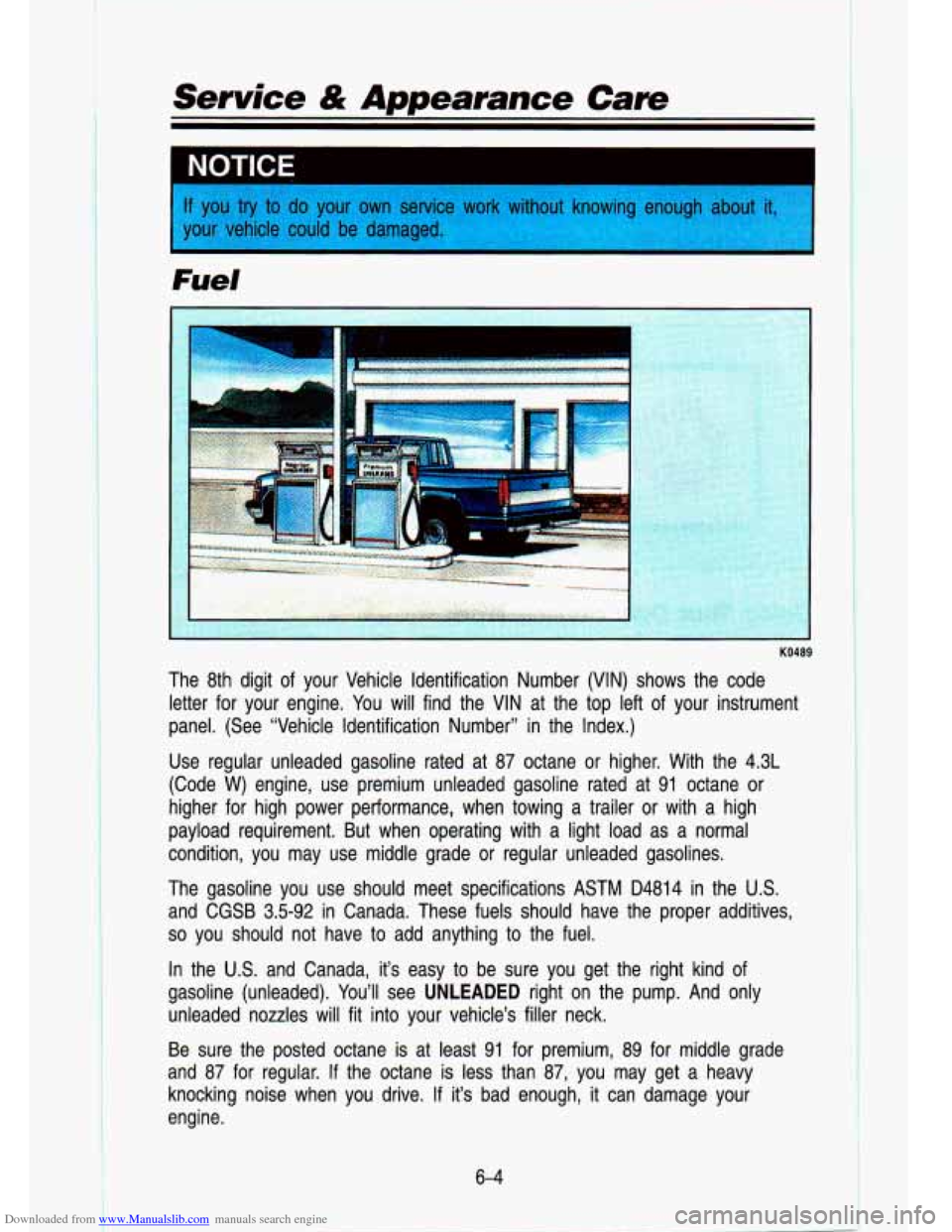
Downloaded from www.Manualslib.com manuals search engine Service & Appearance Care
1 you try to do your own service work without knowing enough abol
'OUI ehicle could be damaged.
Fuel
6-4
Page 253 of 356

Downloaded from www.Manualslib.com manuals search engine If you’re using fuel rated at 91 octane or higher and you still hear heavy
knocking, your engine needs service. But don’t worry
if you hear a little
pinging noise when you’re accelerating or driving up a hill. That’s nor\
mal, and
you don’t have to buy a higher octane fuel to get rid of pinging. It’s the
heavy, constant knock that means you have a problem.
What about gasoline with blending materials that contain oxygen,\
such as
MTBE or alcohol?
MTBE is “methyl tertiary-butyl ether.” Fuel that is no more than
15% MTBE is
fine for your vehicle.
Ethanol is ethyl or grain alcohol. Properly-blended fuel that is no more than
10% ethanol is fine for your vehicle.
Methanol is methyl or wood alcohol.
-uel that is more than
5% methanol is bad for your vehicle. Don’t use il
’ an corrode metal parts in your fuel system and also damage plastic
ma rubber parts. That damage wouldn’t be covered under your Wa-
Znd even at
5% or less, there must be “cosolvent! “ and corrosion
Ireventers
in this fuel to help avoid these problem! I
Gasolines for Cleaner Air
Your use of gasoline with detergent additives will help prevent deposits from
forming in your engine and fuel system. That helps keep your engine in tune
and your emission control system working properly. It’s good \
for your vehicle, and you’ll be doing your part for cleaner air.
Many gasolines are now blended with materials called oxygenates. General
Motors recommends that you use gasolines with these blending ma\
terials,
such as MTBE and ethanol. By doing
so, you can help clean the air,
especially in those parts
of the country that have high carbon monoxide
levels.
In addition, some gasoline suppliers are now producing reformulated \
gasolines. These gasolines are specially designed to reduce vehicle
emissions. General Motors recommends that you use reformulated g\
asoline. By doing
so, you can help clean the air, especially in those parts of the
country that have high ozone levels.
You should ask your service station operators
if their gasolines contain
detergents and oxygenates, and
if they have been reformulated to reduce
vehicle emissions.
6-5
Page 254 of 356

Downloaded from www.Manualslib.com manuals search engine Service & Appearance Care
Fuels in Foreign Countries
If you plan on driving in another country outside the US. or Canada,
unleaded fuel may be hard
to find. Do not use leaded gasoline. If you use
even one tankful, your emission controls won’t work well or at all. With
continuous use, spark plugs can get fouled, the exhaust system \
can corrode,
and your engine oil can deteriorate quickly. Your vehicle’s three-way catalytic
converter and oxygen sensor will be damaged.
All of that means costly
repairs that wouldn’t be covered by your warranty.
To check on fuel availability, ask an auto club, or contact a major oil
company that does business in the country where you’ll be d\
riving.
You can also write us at the following address for advice.
Just tell us where
you’re going and give your Vehicle Identification Number (VI\
N).
General Motors
of Canada Limited
International Export Sales
P.O. Box 828
Oshawa, Ontario LIH 7N1, Canada
Filling Your Tank
A Gasoline vapor is highly flammable. It burns violently, and that can
cause very bad injuries. Don’t smoke if you’re near g’asoline or
aefuel’ing your vehicle. Keep sparks, flames, and smoking mat\
erials
away fmm gasoline.
I
6-6
Page 256 of 356
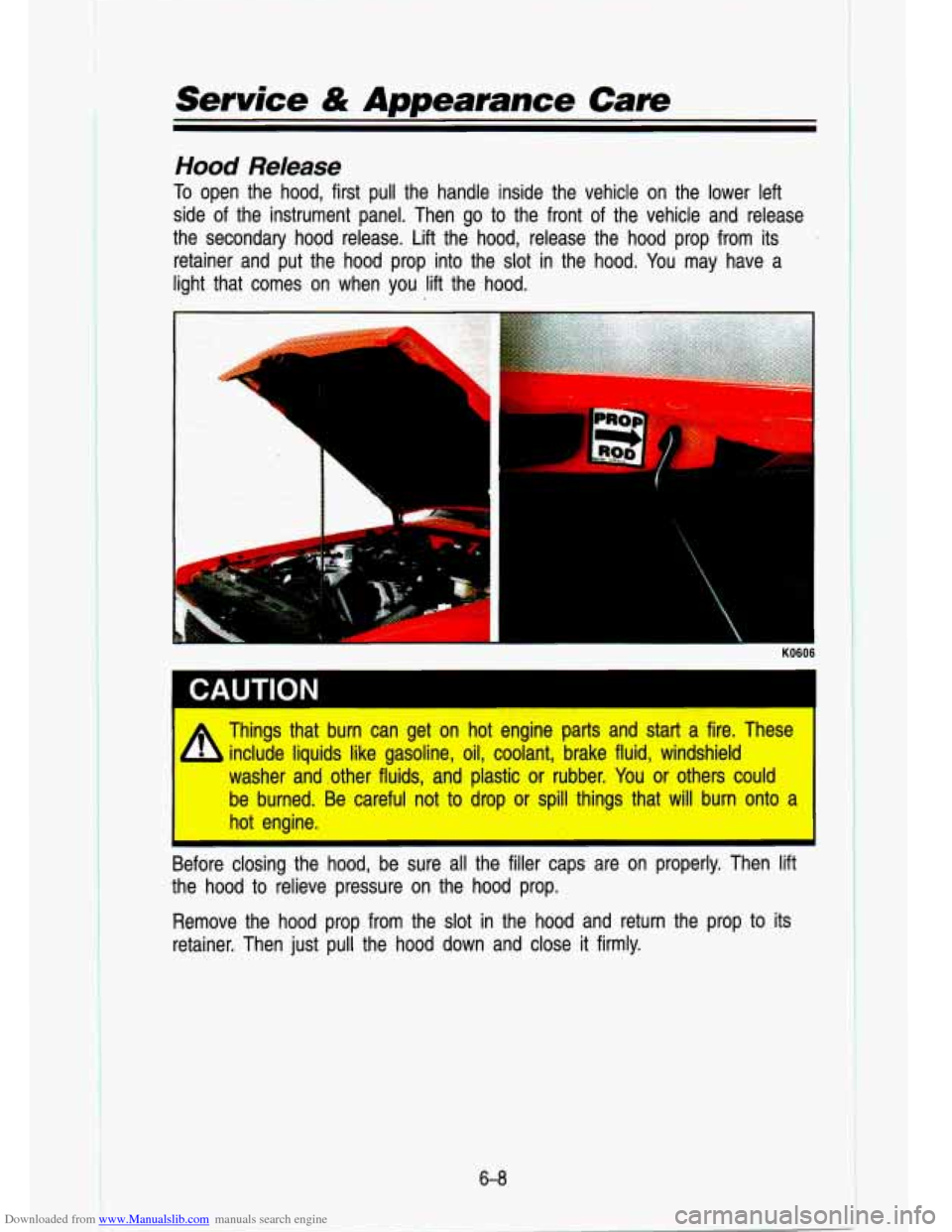
Downloaded from www.Manualslib.com manuals search engine Service & Appearance Care
Hood Release
To open the hood, first pull the handle inside the vehicle on th\
e lower left
side of the instrument panel. Then
go to the front of the vehicle and release
the secondary hood release. Lift the hood, release the hood pr\
op from its
retainer and put the hood prop into the slot in the hood. You may have a
light that comes on when you lift the hood.
L
Thing's that burn can .get on hot engine parts and s'hrt a fire. These I
include liqwids like gasoline, oil, coolant, brake fluid, windshiield
washer and .other fluids, and plastic oir rubber. You or others could
be blurned. Be careful not
to drop or spill thing.s that will bum onto a
hot eng,ine.
L
Before closing the hood, be sure all the filler caps are on properly. Then lift
the hood to relieve pressure on the hood prop.
Remove the hood prop from the slot in the hood and return th\
e prop to its
retainer. Then just pull the hood down and close
it firmly.
6-8